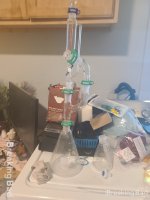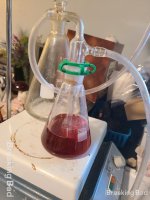G.Patton
Expert
- Joined
- Jul 5, 2021
- Messages
- 2,993
- Solutions
- 3
- Reaction score
- 3,382
- Points
- 113
- Deals
- 1
It is able to fix enough water (over the 30% of its weight considering it hydrates only to CaCl2·2H2O, which is stable up to 150 °C) to deliver a significant amount of HCl gas. In a typical run, 100 g of 35% HCl were added over 100 g of granular CaCl2 at room temperature (the thermal effect is not significant), and 15 g of HCl(g) were obtained. This represents over 40% yield, which may be compared with the 80%, yield reported for the process represented in Eq. 2; however, it uses approximately a 1:3 weight ratio between H2SO4 and HCl(aq).
CaCl2 also is easier to dispose of than H2SO4, and less base is required to neutralize the final waste. An additional advantage of this procedure regarding those based on H2SO4 concerns educational aspects. By heating at 200 °C, the resulting waxy mixture (or crystalline mass to which it converts after a few hours), the anhydrous CaCl2, can be regenerated for re-use once a solution of HCl is obtained. In this case, some calcium oxychloride formed can be ignored.
Even though this may be without value from a practical viewpoint, it may be of educational significance because it attracts attention to topics of current interest such as optimizing of processes, recycling of chemicals, and reducing of wastes. To this end, the assembly shown in Fig. b is more appropriate than that in Fig. a because the resulting mixture is ready to be distilled.
UPD: An alternative way:
Last edited:
- Joined
- Jan 24, 2023
- Messages
- 6
- Reaction score
- 11
- Points
- 3



